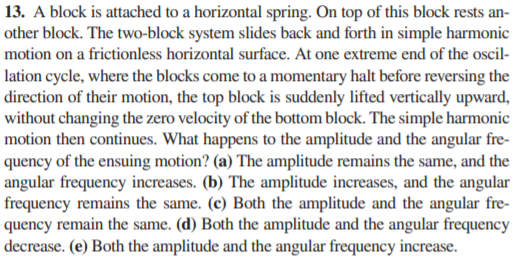13. A block is attached to a horizontal spring. On top of this block rests an- other block. The two-block system slides back and forth in simple harmonic motion on a frictionless horizontal surface. At one extreme end of the oscil- lation cycle, where the blocks come to a momentary halt before reversing the direction of their motion, the top block is suddenly lifted vertically upward, without changing the zero velocity of the bottom block. The simple harmonic motion then continues. What happens to the amplitude and the angular fre- quency of the ensuing motion? (a) The amplitude remains the same, and the angular frequency increases. (b) The amplitude increases, and the angular frequency remains the same. (c) Both the amplitude and the angular fre- quency remain the same. (d) Both the amplitude and the angular frequency decrease. (e) Both the amplitude and the angular frequency increase.
13. A block is attached to a horizontal spring. On top of this block rests an- other block. The two-block system slides back and forth in simple harmonic motion on a frictionless horizontal surface. At one extreme end of the oscil- lation cycle, where the blocks come to a momentary halt before reversing the direction of their motion, the top block is suddenly lifted vertically upward, without changing the zero velocity of the bottom block. The simple harmonic motion then continues. What happens to the amplitude and the angular fre- quency of the ensuing motion? (a) The amplitude remains the same, and the angular frequency increases. (b) The amplitude increases, and the angular frequency remains the same. (c) Both the amplitude and the angular fre- quency remain the same. (d) Both the amplitude and the angular frequency decrease. (e) Both the amplitude and the angular frequency increase.
Physics for Scientists and Engineers, Technology Update (No access codes included)
9th Edition
ISBN:9781305116399
Author:Raymond A. Serway, John W. Jewett
Publisher:Raymond A. Serway, John W. Jewett
Chapter15: Oscillatory Motion
Section: Chapter Questions
Problem 15.11OQ: A block with mass m = 0.1 kg oscillates with amplitude .A = 0.1 in at the end of a spring with force...
Related questions
Question

Transcribed Image Text:13. A block is attached to a horizontal spring. On top of this block rests an-
other block. The two-block system slides back and forth in simple harmonic
motion on a frictionless horizontal surface. At one extreme end of the oscil-
lation cycle, where the blocks come to a momentary halt before reversing the
direction of their motion, the top block is suddenly lifted vertically upward,
without changing the zero velocity of the bottom block. The simple harmonic
motion then continues. What happens to the amplitude and the angular fre-
quency of the ensuing motion? (a) The amplitude remains the same, and the
angular frequency increases. (b) The amplitude increases, and the angular
frequency remains the same. (c) Both the amplitude and the angular fre-
quency remain the same. (d) Both the amplitude and the angular frequency
decrease. (e) Both the amplitude and the angular frequency increase.
Expert Solution
This question has been solved!
Explore an expertly crafted, step-by-step solution for a thorough understanding of key concepts.
This is a popular solution!
Trending now
This is a popular solution!
Step by step
Solved in 3 steps with 2 images

Recommended textbooks for you

Physics for Scientists and Engineers, Technology …
Physics
ISBN:
9781305116399
Author:
Raymond A. Serway, John W. Jewett
Publisher:
Cengage Learning

Principles of Physics: A Calculus-Based Text
Physics
ISBN:
9781133104261
Author:
Raymond A. Serway, John W. Jewett
Publisher:
Cengage Learning

Physics for Scientists and Engineers
Physics
ISBN:
9781337553278
Author:
Raymond A. Serway, John W. Jewett
Publisher:
Cengage Learning

Physics for Scientists and Engineers, Technology …
Physics
ISBN:
9781305116399
Author:
Raymond A. Serway, John W. Jewett
Publisher:
Cengage Learning

Principles of Physics: A Calculus-Based Text
Physics
ISBN:
9781133104261
Author:
Raymond A. Serway, John W. Jewett
Publisher:
Cengage Learning

Physics for Scientists and Engineers
Physics
ISBN:
9781337553278
Author:
Raymond A. Serway, John W. Jewett
Publisher:
Cengage Learning

Physics for Scientists and Engineers with Modern …
Physics
ISBN:
9781337553292
Author:
Raymond A. Serway, John W. Jewett
Publisher:
Cengage Learning

Physics for Scientists and Engineers: Foundations…
Physics
ISBN:
9781133939146
Author:
Katz, Debora M.
Publisher:
Cengage Learning